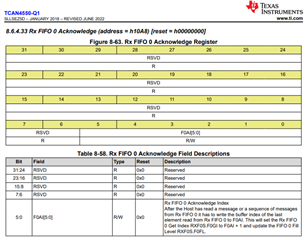Hi team,
Customer has below questions of TCAN4550-Q1
When they test CAN message sending and receiving, when using the receiving FIFO, because the RX FIFO capacity is too small, when the bus load is high, the RX FIFO will be filled, resulting in missed frames of the message.
They would like to ask a few questions,
1. When the FIFO receive buffer is read, will it continue to receive messages on the bus?
2. If you continue to receive, will the received messages be queued after the messages already in the FIFO, or will they be stored as long as there is free space in the FIFO?
Thank you
Scarlett



